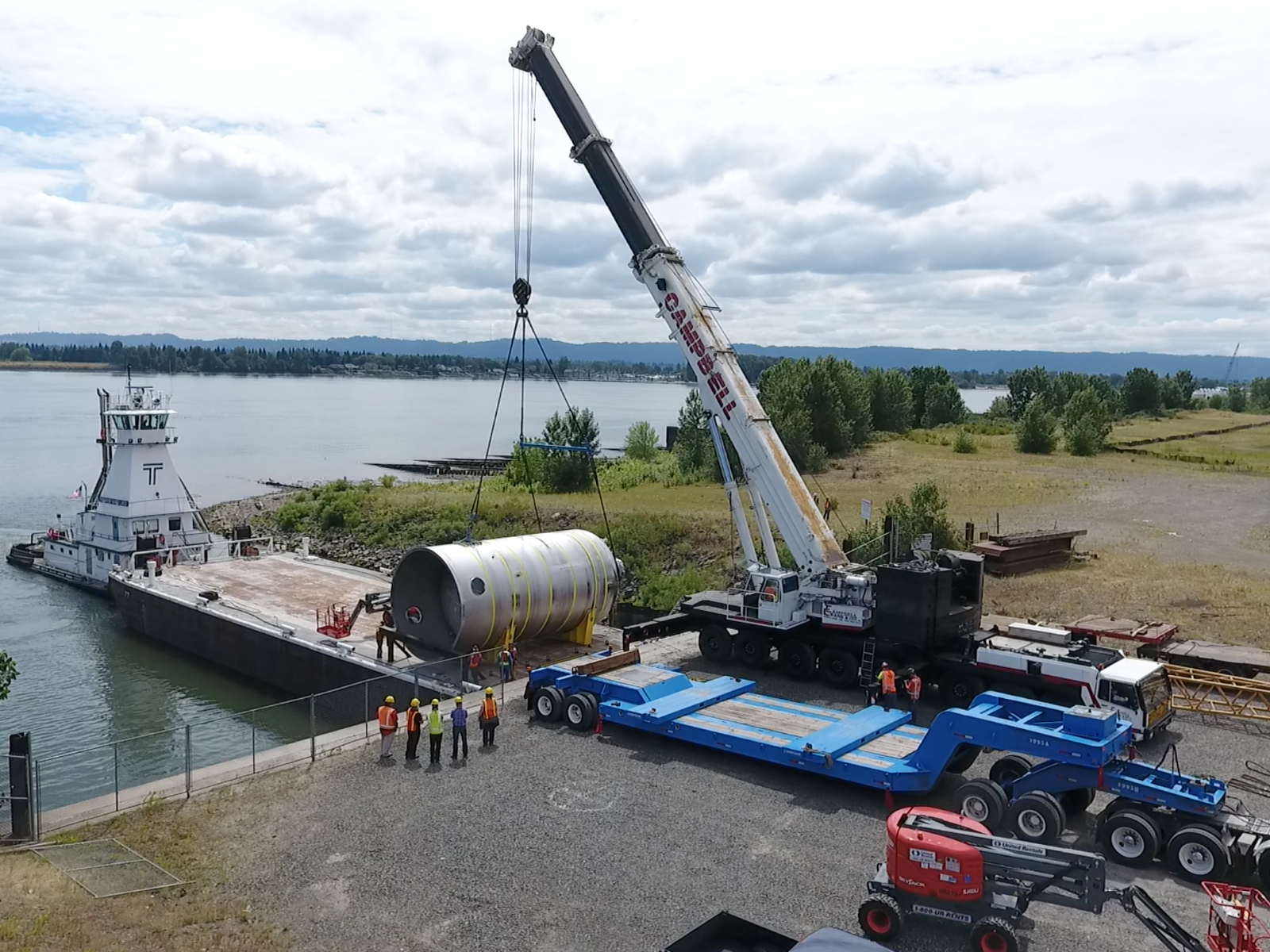PNNL Helps Hanford Cleanup

This 65-ton stainless steel vessel was barged up the Columbia River from Vancouver to Richland last summer. PNNL researchers are helping Bechtel National test the vessels that will receive, store and process radioactive sludge at the Waste Treatment and Immobilization Plant's Pretreatment Facility before it is vitrified. The full-scale vessel is 35 feet high with a 16-foot diameter and 22,000-gallon capacity.
(Photo courtesy of Bechtel)
Cleaning up Hanford is no easy task: it is one of the world's largest and most complex environmental remediation projects. The nation's top engineering firms are on the job and the Department of Energy's Pacific Northwest National Laboratory is helping.
Over the course of five decades, PNNL has developed a deep understanding of the site and its many challenges—and we have consistently delivered innovative solutions that support the cleanup mission, while protecting workers and our beautiful Columbia River.
One of the biggest challenges involves treating and disposing of 56 million gallons of radioactive waste remaining from the nation's nuclear weapons production mission, stored in underground tanks. The Waste Treatment and Immobilization Plant (WTP), a first-of-a-kind project of immense scale and complexity, is being built by Bechtel National Inc. to vitrify this waste. Specifically, the waste will be mixed with glass-forming materials and melted into a durable glass form for safe, long-term storage.
PNNL is world-renowned for its expertise in glass formulation and processing—knowledge that is instrumental to the work done in partnership with the DOE Office of River Protection (ORP) to develop the vitrification process. Recently, PNNL developed new techniques to determine whether the heating and cooling system planned for the WTP could maintain safe temperatures as the glass cools. Our results showed that the system is more than adequate and may be able to support higher production rates, potentially saving time and reducing costs.
In another project, PNNL researchers are helping Bechtel engineers resolve one of the major technical questions at WTP. Together, we are supporting their efforts to test the vessels that will receive, store and process radioactive sludge at the Pretreatment Facility before it is vitrified, as well as helping test the vessels' controls and equipment. Full-scale testing began in December to ensure the design concepts will meet mixing requirements in a specific range of simulant properties. In addition, we are using our supercomputing capabilities and advanced modeling to evaluate fluid dynamics within the vessels.
A different application of our computational capabilities enables us to peer into the Earth's subsurface, similar to how medical scans allow doctors to see within our bodies. With support from DOE's Offices of Science and Environmental Management, as well as DOE Richland and CH2M Hill Plateau Remediation Company, PNNL developed award-winning four-dimensional subsurface imaging software that allows us to monitor Hanford groundwater and soil for contaminants remotely in real time.
The software uses supercomputers to analyze large amounts of data—and to turn this data into images of the subsurface, including the ability to account for buried metallic infrastructure like waste tanks and pipes.
We also are assisting in the area of worker safety. For example, we are helping Washington River Protection Solutions and ORP test a system that would collect data from chemical sensors and other equipment to constantly monitor Hanford Tank Farms for vapor releases—and alert workers with information if they need to respond rapidly.
In a related effort, PNNL is analyzing data from respirator cartridge testing to evaluate how the cartridges perform when exposed directly to tank farm vapors. The results provide cartridge service life recommendations that help industrial hygienists determine when air-purifying respirators are effective and appropriate for use by workers in the Tank Farm.
These are just a few of examples of our contributions to the important Hanford cleanup mission. At PNNL, we are proud of our Hanford heritage and committed to our community's future. And that means supporting DOE and Hanford contractors in their efforts to tackle this extraordinary remediation challenge.
We appreciate the opportunity to be part of the solution. After all, we live here!
Steven Ashby, director of Pacific Northwest National Laboratory, writes this column monthly. To read previous Director's Columns, visit pnnl.gov/news and filter by Director's Columns in our Latest Stories.
Published: February 18, 2017